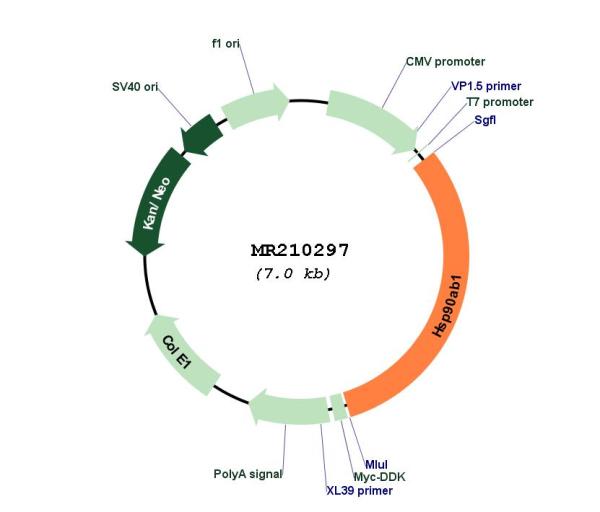Hsp90ab1 (NM_008302) Mouse Tagged ORF Clone
CAT#: MR210297
- TrueORF®
Hsp90ab1 (Myc-DDK-tagged) - Mouse heat shock protein 90 alpha (cytosolic), class B member 1 (Hsp90ab1)
ORF Plasmid: tGFP
Lentiviral Particles: DDK w/ Puro mGFP w/ Puro
"NM_008302" in other vectors (4)
Interest in protein/lysate? Submit request here!
USD 198.00
Specifications
| Product Data | |
| Type | Mouse Tagged ORF Clone |
| Tag | Myc-DDK |
| Symbol | Hsp90ab1 |
| Synonyms | 90kDa; AL022974; C81438; Hsp84; Hsp84-1; Hsp90; Hspcb |
| Vector | pCMV6-Entry |
| E. coli Selection | Kanamycin (25 ug/mL) |
| Mammalian Cell Selection | Neomycin |
| Sequence Data |
>MR210297 representing NM_008302
Red=Cloning site Blue=ORF Green=Tags(s) TTTTGTAATACGACTCACTATAGGGCGGCCGGGAATTCGTCGACTGGATCCGGTACCGAGGAGATCTGCC GCCGCGATCGCC ATGCCTGAGGAAGTGCACCATGGAGAGGAGGAGGTGGAGACCTTTGCCTTTCAGGCAGAAATTGCCCAGC TCATGTCCCTCATCATCAACACTTTCTATTCAAACAAGGAGATTTTCCTCCGCGAGTTGATCTCTAATGC TTCAGATGCCCTGGACAAGATTCGATATGAGAGCCTGACGGACCCTTCTAAGTTGGACAGTGGGAAAGAG CTGAAAATTGACATCATCCCCAACCCTCAGGAGCGCACGCTGACTTTGGTGGACACAGGCATTGGCATGA CCAAGGCTGACCTCATTAATAACCTGGGAACCATTGCTAAGTCTGGCACGAAGGCGTTCATGGAGGCTCT CCAGGCTGGTGCAGACATCTCCATGATCGGGCAGTTTGGTGTCGGATTCTACTCGGCCTATCTAGTTGCA GAGAAAGTGGTTGTGATCACGAAGCACAATGATGATGAGCAGTATGCCTGGGAGTCGTCTGCGGGTGGCT CCTTCACCGTCCGGGCAGACCATGGTGAGCCCATTGGCCGGGGTACCAAAGTGATCCTTCACCTCAAAGA AGACCAGACAGAGTACTTGGAGGAGAGGAGGGTCAAGGAAGTGGTGAAGAAACATTCGCAGTTCATAGGC TATCCCATCACCCTCTATTTGGAGAAGGAACGGGAGAAGGAGATCAGTGATGATGAGGCAGAGGAAGAGA AAGGTGAGAAAGAGGAGGAAGATAAGGAGGATGAGGAGAAGCCTAAGATTGAAGATGTGGGATCCGATGA GGAAGATGACAGCGGCAAAGACAAGAAAAAGAAAACAAAGAAGATCAAAGAGAAGTACATTGACCAGGAG GAGCTGAACAAGACAAAGCCTATCTGGACCAGAAACCCGGATGACATCACGCAGGAGGAGTATGGCGAAT TCTATAAGAGCCTCACCAATGACTGGGAGGACCACTTGGCAGTCAAGCACTTCTCTGTAGAAGGTCAGTT GGAATTCAGGGCATTGCTCTTCATTCCCCGGCGGGCTCCCTTCGACCTTTTTGAGAACAAGAAGAAGAAG AACAACATCAAATTGTATGTCCGCCGTGTGTTCATCATGGACAGCTGTGACGAGCTGATACCTGAGTACC TCAACTTTATCCGCGGTGTGGTTGACTCCGAGGACCTGCCCCTGAACATCTCCCGGGAGATGCTGCAGCA GAGCAAGATCCTGAAGGTCATCCGCAAGAACATCGTCAAGAAGTGCCTGGAGCTCTTCTCCGAGCTGGCT GAGGACAAGGAGAACTACAAGAAGTTCTATGAGGCCTTCTCCAAAAATTTAAAGCTTGGAATTCATGAAG ATTCCACTAACCGACGCCGCCTCTCTGAGCTCCTTCGCTATCACACCTCTCAGTCTGGAGATGAGATGAC CTCCTTGTCAGAGTATGTGTCTCGCATGAAGGAGACCCAGAAGTCCATCTACTATATCACTGGTGAGAGC AAAGAGCAAGTGGCCAACTCTGCCTTTGTGGAGCGAGTGCGGAAGCGGGGCTTCGAGGTGGTGTATATGA CTGAGCCTATTGACGAGTACTGCGTGCAGCAGCTCAAGGAGTTTGATGGGAAGAGCCTGGTCTCAGTGAC TAAGGAGGGCCTGGAGCTACCAGAGGACGAGGAAGAGAAGAAGAAAATGGAGGAGAGCAAGGCAAAGTTT GAGAATCTCTGCAAGCTCATGAAGGAGATCTTGGACAAGAAGGTTGAAAAGGTGACAATCTCCAATAGGC TTGTGTCTTCACCCTGCTGCATTGTGACAAGCACCTATGGCTGGACAGCCAACATGGAACGGATCATGAA GGCCCAGGCACTGCGAGACAACTCTACAATGGGCTACATGATGGCCAAAAAACACCTGGAGATCAACCCT GACCACCCCATCGTGGAGACCCTGCGGCAGAAGGCTGAGGCAGACAAAAACGACAAAGCTGTCAAGGACC TGGTGGTGCTGCTGTTTGAAACTGCTCTGCTCTCCTCTGGTTTCTCACTTGAGGATCCCCAAACCCACTC CAACCGCATCTACCGCATGATTAAACTAGGCCTGGGCATCGATGAAGATGAGGTCACTGCAGAGGAGCCC AGTGCTGCTGTTCCTGATGAGATCCCCCCTCTGGAAGGCGATGAGGATGCCTCGCGCATGGAAGAGGTGG AT ACGCGTACGCGGCCGCTCGAGCAGAAACTCATCTCAGAAGAGGATCTGGCAGCAAATGATATCCTGGATT ACAAGGATGACGACGATAAGGTTTAA >MR210297 representing NM_008302
Red=Cloning site Green=Tags(s) MPEEVHHGEEEVETFAFQAEIAQLMSLIINTFYSNKEIFLRELISNASDALDKIRYESLTDPSKLDSGKE LKIDIIPNPQERTLTLVDTGIGMTKADLINNLGTIAKSGTKAFMEALQAGADISMIGQFGVGFYSAYLVA EKVVVITKHNDDEQYAWESSAGGSFTVRADHGEPIGRGTKVILHLKEDQTEYLEERRVKEVVKKHSQFIG YPITLYLEKEREKEISDDEAEEEKGEKEEEDKEDEEKPKIEDVGSDEEDDSGKDKKKKTKKIKEKYIDQE ELNKTKPIWTRNPDDITQEEYGEFYKSLTNDWEDHLAVKHFSVEGQLEFRALLFIPRRAPFDLFENKKKK NNIKLYVRRVFIMDSCDELIPEYLNFIRGVVDSEDLPLNISREMLQQSKILKVIRKNIVKKCLELFSELA EDKENYKKFYEAFSKNLKLGIHEDSTNRRRLSELLRYHTSQSGDEMTSLSEYVSRMKETQKSIYYITGES KEQVANSAFVERVRKRGFEVVYMTEPIDEYCVQQLKEFDGKSLVSVTKEGLELPEDEEEKKKMEESKAKF ENLCKLMKEILDKKVEKVTISNRLVSSPCCIVTSTYGWTANMERIMKAQALRDNSTMGYMMAKKHLEINP DHPIVETLRQKAEADKNDKAVKDLVVLLFETALLSSGFSLEDPQTHSNRIYRMIKLGLGIDEDEVTAEEP SAAVPDEIPPLEGDEDASRMEEVD TRTRPLEQKLISEEDLAANDILDYKDDDDKV |
| Restriction Sites |
SgfI-MluI
Cloning Scheme for this gene
Plasmid Map

|
| ACCN | NM_008302 |
| ORF Size | 2172 bp |
| OTI Disclaimer | Due to the inherent nature of this plasmid, standard methods to replicate additional amounts of DNA in E. coli are highly likely to result in mutations and/or rearrangements. Therefore, OriGene does not guarantee the capability to replicate this plasmid DNA. Additional amounts of DNA can be purchased from OriGene with batch-specific, full-sequence verification at a reduced cost. Please contact our customer care team at custsupport@origene.com or by calling 301.340.3188 option 3 for pricing and delivery. The molecular sequence of this clone aligns with the gene accession number as a point of reference only. However, individual transcript sequences of the same gene can differ through naturally occurring variations (e.g. polymorphisms), each with its own valid existence. This clone is substantially in agreement with the reference, but a complete review of all prevailing variants is recommended prior to use. More info |
| OTI Annotation | This clone was engineered to express the complete ORF with an expression tag. Expression varies depending on the nature of the gene. |
| Product Components | The ORF clone is ion-exchange column purified and shipped in a 2D barcoded Matrix tube containing 10ug of transfection-ready, dried plasmid DNA (reconstitute with 100 ul of water). |
| Reconstitution | 1. Centrifuge at 5,000xg for 5min. 2. Carefully open the tube and add 100ul of sterile water to dissolve the DNA. 3. Close the tube and incubate for 10 minutes at room temperature. 4. Briefly vortex the tube and then do a quick spin (less than 5000xg) to concentrate the liquid at the bottom. 5. Store the suspended plasmid at -20°C. The DNA is stable for at least one year from date of shipping when stored at -20°C. |
| Reference Data | |
| RefSeq | NM_008302.3, NP_032328.2 |
| RefSeq Size | 2507 bp |
| RefSeq ORF | 2175 bp |
| Locus ID | 15516 |
| UniProt ID | P11499 |
| Cytogenetics | 17 22.59 cM |
| MW | 83.7 kDa |
| Gene Summary | Molecular chaperone that promotes the maturation, structural maintenance and proper regulation of specific target proteins involved for instance in cell cycle control and signal transduction. Undergoes a functional cycle that is linked to its ATPase activity. This cycle probably induces conformational changes in the client proteins, thereby causing their activation. Interacts dynamically with various co-chaperones that modulate its substrate recognition, ATPase cycle and chaperone function. Engages with a range of client protein classes via its interaction with various co-chaperone proteins or complexes, that act as adapters, simultaneously able to interact with the specific client and the central chaperone itself. Recruitment of ATP and co-chaperone followed by client protein forms a functional chaperone. After the completion of the chaperoning process, properly folded client protein and co-chaperone leave HSP90 in an ADP-bound partially open conformation and finally, ADP is released from HSP90 which acquires an open conformation for the next cycle. Apart from its chaperone activity, it also plays a role in the regulation of the transcription machinery. HSP90 and its co-chaperones modulate transcription at least at three different levels. In the first place, they alter the steady-state levels of certain transcription factors in response to various physiological cues. Second, they modulate the activity of certain epigenetic modifiers, such as histone deacetylases or DNA methyl transferases, and thereby respond to the change in the environment. Third, they participate in the eviction of histones from the promoter region of certain genes and thereby turn on gene expression. Antagonizes STUB1-mediated inhibition of TGF-beta signaling via inhibition of STUB1-mediated SMAD3 ubiquitination and degradation. Promotes cell differentiation by chaperoning BIRC2 and thereby protecting from auto-ubiquitination and degradation by the proteasomal machinery. Main chaperone that is involved in the phosphorylation/activation of the STAT1 by chaperoning both JAK2 and PRKCE under heat shock and in turn, activates its own transcription.[UniProtKB/Swiss-Prot Function] |
Documents
| Product Manuals |
| FAQs |
| SDS |
Resources
Other Versions
| SKU | Description | Size | Price |
|---|---|---|---|
| MC221078 | Hsp90ab1 (untagged) - Mouse heat shock protein 90 alpha (cytosolic), class B member 1 (Hsp90ab1), (10ug) |
USD 1,062.00 |
|
| MG210297 | Hsp90ab1 (tGFP-tagged) - Mouse heat shock protein 90kDa alpha (cytosolic), class B member 1 (Hsp90ab1) |
USD 1,194.00 |
|
| MR210297L3 | Lenti ORF clone of Hsp90ab1 (Myc-DDK-tagged) - Mouse heat shock protein 90 alpha (cytosolic), class B member 1 (Hsp90ab1) |
USD 1,294.00 |
|
| MR210297L4 | Lenti ORF clone of Hsp90ab1 (mGFP-tagged) - Mouse heat shock protein 90 alpha (cytosolic), class B member 1 (Hsp90ab1) |
USD 1,294.00 |
{0} Product Review(s)
Be the first one to submit a review






























































































































































































































































 Germany
Germany
 Japan
Japan
 United Kingdom
United Kingdom
 China
China


